Menu
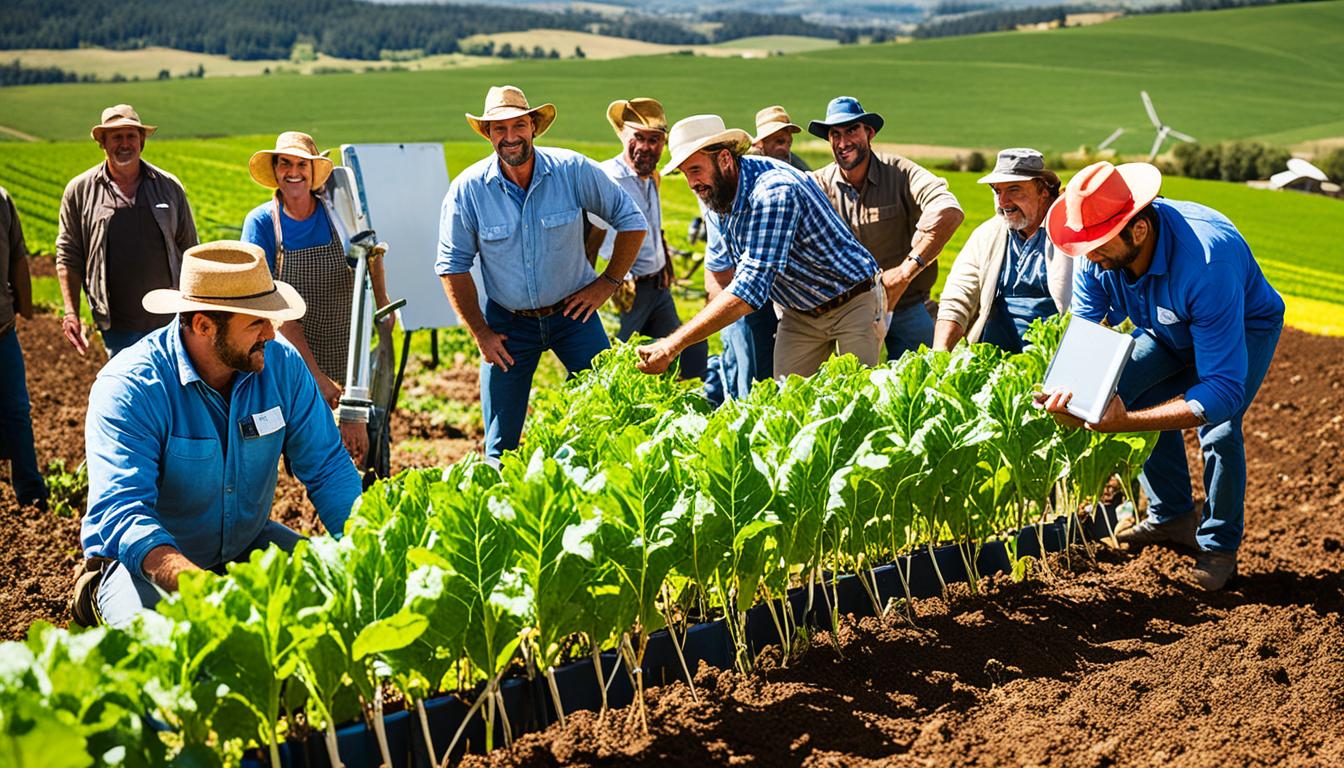
Within the next 30 years, global food supply faces a severe threat from climate change. Farmers are fighting against rising temperatures, erratic weather, and water scarcity. They are using sustainable agriculture to show adaptability.
Initiatives like Drylands Agroecology Research are making a big difference. They have saved 75,000 gallons of water and planted 15,000 trees. This shows the power of working together in farming to fight climate change.
Climate change is a major issue for the farming world. It brings higher temperatures and strange weather. This makes it hard for farmers to know when to grow their crops. To deal with these issues, farmers are using new ways of farming that are good for the planet.
Warmer temperatures change the way farmers work. They lead to longer dry spells, heatwaves, and different times for planting and harvesting. The weather isn’t as it used to be, which makes it tough to plan. Farmers deal with this by using smart technology and sticking to ways of farming that protect the environment.
Warm and changing weather also means more pests and diseases. This hurts how much food we can grow. It’s like a perfect place for pests to live, making farming even harder. To fight back, farmers are changing the ways they farm and agreeing on rules together. This helps keep their crops safe from harm.
Rain and water are also acting differently because of climate change. This means less water for crops. When rain comes, it’s hard to guess, which makes farming less reliable. Farmers are using less water and improving how they water their crops. These changes help them use less water and stand up to tough weathers.
Actions such as creating strong crops show how farmers are being smart and getting ready. They are doing their best to lower the bad effects of climate change.
By working together, AgMission links everyone trying to help the farming world get better. This support joins farmers, animal owners, and scientists. It shows a big move towards farming that does not harm the earth. Together, sharing what works best makes the farming world ready to face climate change.
Climate adaptation is key in reducing the harm of climate change. Diversification is a strong tool for farmers. It involves growing different crops, raising varied livestock, and looking into smaller markets. All these actions help make farming strong against climate challenges.
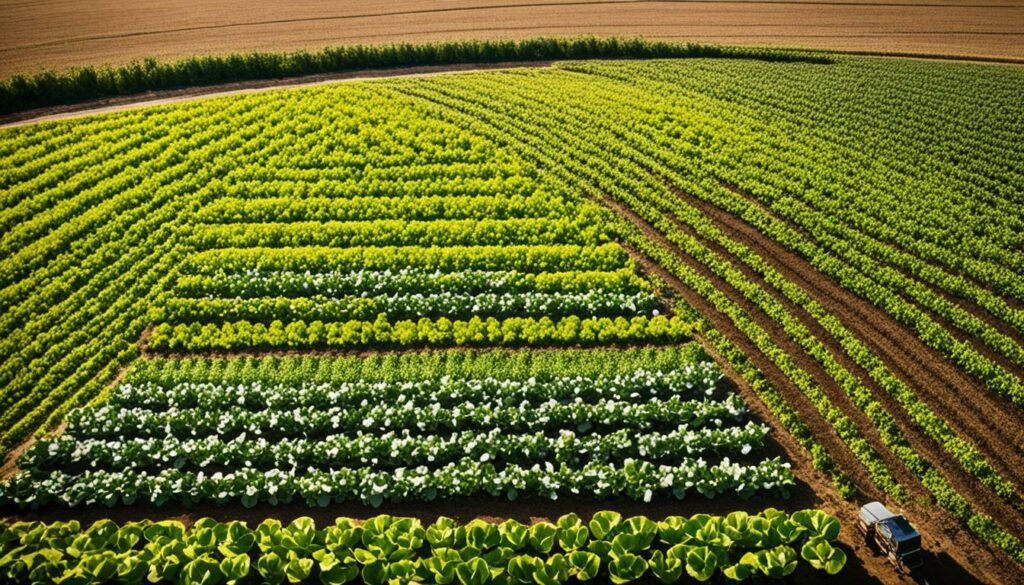
Planting different crops is vital for resilient farming. In Peru, the CIP introduced the CIP-Matilde potato. It’s resistant to diseases and improves farming’s ability to cope with change. Genebanks also matter, like the ones from the Crop Trust, storing seeds for tough times. This ensures food security and helps farming adapt, even in the worst conditions.
Having various livestock is key too. In Ethiopia, households with different animals sell more and are more secure food-wise. This way, they deal better with changes in climate and manage resources like water and pastures. This mix of livestock helps farmers face climate risks and become more resilient.
Looking at special markets helps farmers economically. Those who grow a variety of crops and raise different animals often find success in these markets. This method supports good soil and sustainable farming. Niche markets also provide an extra income. This is especially important as the climate gets more unpredictable.
“Adoption of climate-resilient crops through genebanks can ensure food security for future generations.”
Diversified farming is good for more than just fighting climate change. It improves soil health and what we eat. Places like Sub-Saharan Africa need more of it. Combining crops and animals can offer even more benefits.
| Region | Diversification Practices | Impact |
|---|---|---|
| Ethiopia | Livestock diversification | Higher sales & improved food security |
| Namibia | Crop and livestock diversification | Enhanced resilience to climate change |
Climate change is pushing farmers to adopt new tech tools. These help them use resources better and protect the environment. Techniques like precision agriculture and data-driven farming are making a big difference.
Precision agriculture uses GPS, drones, and sensors to watch over crops. This details where to use fertilisers and pesticides which cuts waste and boosts crop yields. In Rajasthan, this approach alongside modern tech and irrigation canals has lifted farming production by a mile.
Data technology is making smart farming even smarter. With soil checks and weather predictions, farmers are choosing the best times to plant and harvest. This not only grows better crops but makes farms more sustainable. The Smarter Climate Farmers Challenge by UpLink underlines how many are moving this way.
New irrigation systems are saving water and making farms productive. For instance, Spowdi’s mobile drip irrigation system uses solar power and cuts water waste. Kheyti farmers, meanwhile, have shown they can grow a lot more food using a lot less water. They’ve even raised their income by up to 150%.
| Technology | Impact | Statistics |
|---|---|---|
| Precision Agriculture | Optimises resource use, reduces wastage | 35% increase in productivity |
| Data-Driven Farming | Informs decisions, enhances yield | 246 global solutions in UpLink’s challenge |
| Climate-Smart Irrigation | Conserves water, cuts carbon dependency | 7x food growth with 1/5th water usage |
Sustainable farming is key for protecting the environment in agriculture. It includes techniques like conservation tillage. This kind of tillage is good for the earth and helps you get more done. Conservation tillage keeps the soil healthy by disturbing it less. This means it keeps carbon in the ground and makes soil better and reduces erosion.
Limiting soil disruption, conservation tillage makes the earth better. It keeps carbon where it should be – in the soil. By doing this, the earth becomes more fertile and healthier. So, farmers get better harvests and the soil stays good.
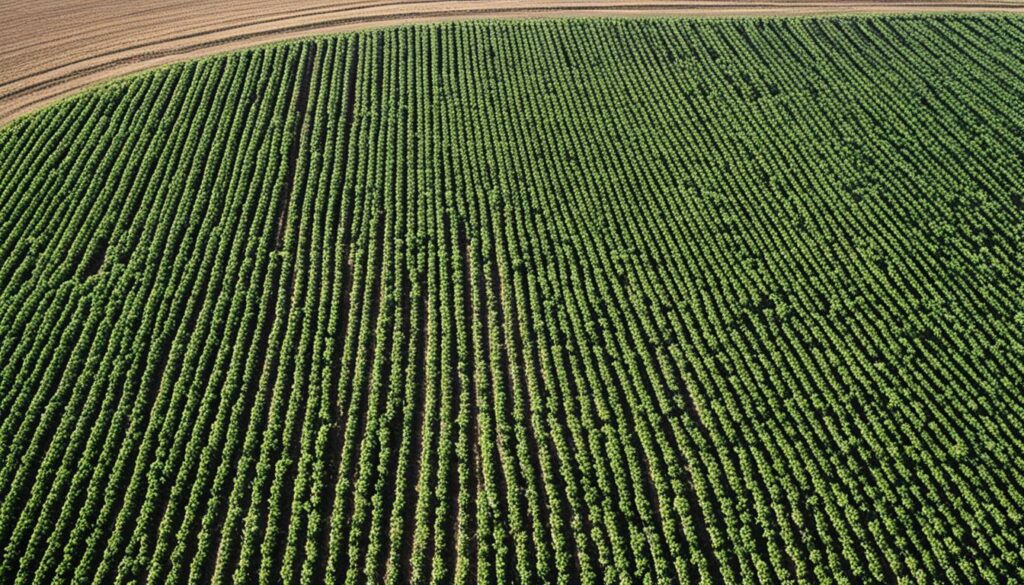
Crop rotation and cover cropping are also fundamental in sustainable farming. Rotating crops makes the soil stronger and protects it from bugs. It also stops the soil from washing away. Plus, it helps the land heal, so crops are healthier. Adding cover crops piles up organic stuff in the soil, making it hold onto water better.
Using water right and saving it is more and more important in farming. Ways like drip and rainwater harvesting help. They make sure farms use water well and help handle dry times better. This way, they save water and make sure there’s enough when it’s really needed.
In conclusion, using methods like conservation tillage and proper water use helps the planet. These tools protect nature and tackle the tests of changing weather. Together, they make farms better for the long run.
| Sustainable Practice | Key Benefits | Adoption Techniques |
|---|---|---|
| Conservation Tillage | Enhanced soil structure and fertility | Minimal soil disruption; Increased organic matter |
| Crop Rotation and Cover Cropping | Improved pest control; Better soil health | Rotating crops; Using cover crops |
| Water Recycling | Optimal water usage; Drought mitigation | Drip irrigation; Rainwater harvesting |
The agricultural sector faces big challenges from climate change. Tackling these issues needs a joint effort from both local and global levels. Farmers and producers should come together to share what works, resources, and experiences. This sharing helps to fight off bad climate effects and push for farming that doesn’t harm the planet. Working together also means connecting farmers worldwide and at home, sharing farming know-how, mixing different technical skills, and making sure money reaches the farmers who need it.
Setting up strong connections with other farmers nearby and far away is key for adapting to climate changes in farming. Joining these groups lets farmers swap critical ideas and the best ways to work the land. This way, they get to use new, well-proven solutions to tough farming problems, like growing crops that can handle more heat or beating back new kinds of pests.
Sharing what we know and what we have is vital in the fight against climate change in farming. Let’s take the Agricultural Climate Resiliency Program as an example. This project gave $1.25 million over three years to boost efforts against climate change. Working together, Michigan State University, the state of Michigan, and different groups for plant farming help farmers improve fruit trees, use eco-friendly farming, and set up tougher crops. They gather and share info on things like how the earth’s water moves or how much pollution affects the land, making big steps forward.
Getting expert farming tips and financial help is key to using smart solutions against climate change. For instance, a team-up between Michigan State University and the Michigan Department of Agriculture makes a big difference. This support helps farmers use new tools to watch over the land and fight things like harmful plant diseases. In the UK, farmers find it hard to follow the many advice about cutting greenhouse gases. With help tailored to their needs, they can smoothly switch to ways that protect the environment.
Bringing together facts about how climate change affects the economy and actual farming helps farmers a lot. This kind of study gives farmers the know-how and tools they need to stop the worst of climate change. By working this way, farmers can get ready for the changes in nature that are coming their way.
Developing climate-resilient crops is vital. These crops can handle tough conditions and need fewer resources. This is done through careful breeding.
Programmes like the one at the International Rice Research Institute have made progress. They created Green Super Rice, which can handle drought and fights off disease. In Spain, the Hot Climate Programme developed the Tutti apple for hot areas. Such work shows how breeding and changing genes can help crops deal with drought and heat.
Farmers are turning to these sturdy crops to fight climate change. Since half of the land is already in use, there’s not much space left for more farms. So, they use high-yield crops and rotate their plants. For example, CIMMYT’s Drought Tolerant Maize for Africa has made more than 160 tough maize types. This greatly helps with food in sub-Saharan Africa.
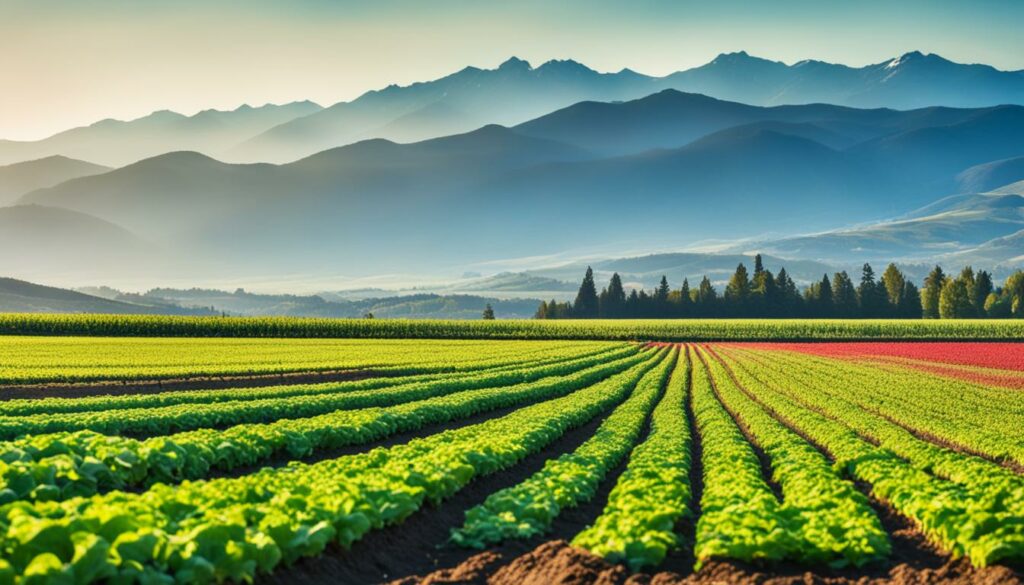
These special crops need less help from chemicals, cutting down on spray and fertilisers. This means less harm to the Earth. Also, farming is kinder to the environment because of using less water, like with drip systems.
It’s not just about the crops themselves. We need to use a mix of strong breeding, adopting these tough crops, and friendly ways of farming. We must keep supporting research to make sure we have enough food for everyone in the future.
| Programme | Initiative | Impact |
|---|---|---|
| CIMMYT | Drought Tolerant Maize for Africa | Released over 160 maize varieties |
| IRRI | Green Super Rice | Drought and disease-resistant rice with high yield potential |
| HCP | Tutti Apple | Adapted to hot climate areas |
Climate change calls for strong climate-smart farm infrastructure. It’s key to keeping farms going. The Inflation Reduction Act (IRA) poured a lot of money into this. The Environmental Quality Incentives Program (EQIP) got $8.45 billion. The Conservation Stewardship Program (CSP) was given $3.25 billion. These funds aim to make our farms ready for bad weather. It also wants to keep farming methods sustainable.
Creating strong farm buildings is vital in smart farming. They can take on big storms, keeping our resources safe. This lowers the risk of losing stuff. By having good storage, our food stays safe even if the weather is weird. Using natural parts like wetlands and buffer zones help too. They make farms tougher against tough times.
Natural parts are a big help against the climate. Things like wetlands stop soil washing away and make a special place for plants. This way, farms rely less on man-made things. Sustainability gets a boost this way. The Regional Conservation Partnership Program (RCPP) got nearly $5 billion to help. It pushes for working together to make farms friendlier to nature.
Stopping soil loss is vital for farm health. Things like cover crops and keeping the land covered with plants help a lot. The Agriculture Conservation Easement Program (ACEP) got $1.4 billion to focus on this. By stopping soil from washing away, farms stay good for growing food. This is essential in a time of climate change.
| Program | Funding Allocation |
|---|---|
| Environmental Quality Incentives Program (EQIP) | $8.45 billion |
| Conservation Stewardship Program (CSP) | $3.25 billion |
| Agriculture Conservation Easement Program (ACEP) | $1.4 billion |
| Regional Conservation Partnership Program (RCPP) | $4.95 billion |
| Conservation Technical Assistance (CTA) | $1 billion |
As we pave the way for farms that can face climate changes, we must build strong, eco-friendly places. This lets farms do well despite the tough weather. It’s all about making our farms not only strong but also safe for the environment.
The pressure from climate change urges farmers to always learn and innovate. They should take part in workshops and climate-smart agriculture courses to stay updated. This way, they can effectively deal with the changing climate.
Learning about climate-smart agriculture helps farmers adopt the latest sustainable farming methods. These methods include using less water and producing fewer greenhouse gases. In a study, farmers reduced GHG emissions in rice farming by 30-45% using these practices.
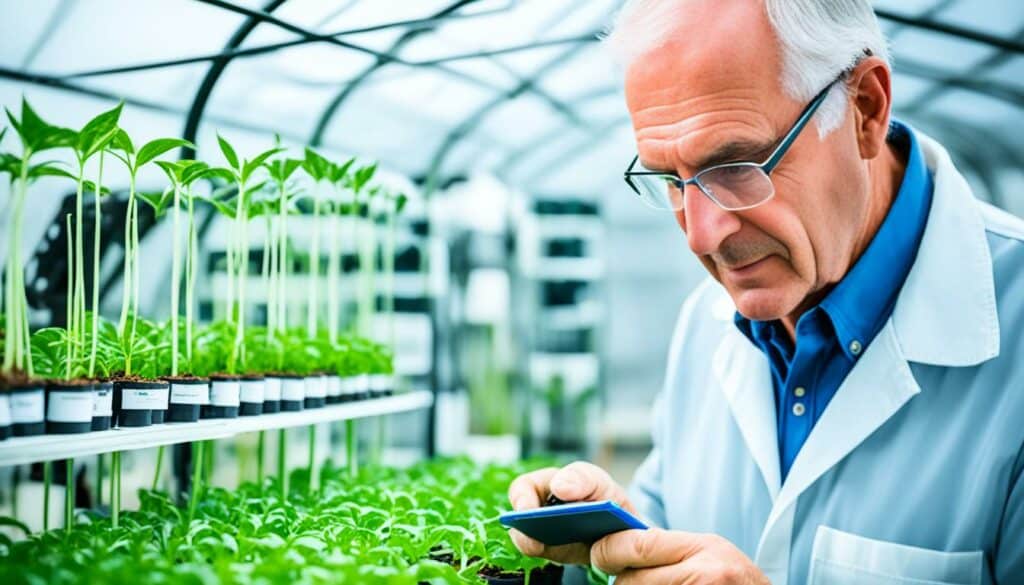
Farmers need to update their practices and know about new technologies. They can do this with the help of digital tools, made for all types of phones. These tools are made with the input of farmers and experts, showing the power of teamwork in agriculture.
Encouraging agricultural innovation is crucial for fighting climate change. Using new methods, farmers can lower emissions significantly. Switching to these methods can cut greenhouse gases as much as a single car’s yearly emissions.
The focus on learning and innovation prepares farmers for climate change’s challenges. By taking part in workshops and continually updating practices, they can succeed in eco-friendly farming.
| Aspect | Statistics |
|---|---|
| GHG Reduction in Rice Cultivation | 30-45% |
| Average Emissions Reduction per Hectare | 4tCO2e |
| Annual Emissions of a Passenger Car | 4.6tCO2e |
| Target Hectares for Transition by 2030 | 1 million hectares |
Government policies help steer agriculture towards a future that’s ready for change. Leading this is the US Department of Agriculture (USDA). It works hard to make the agriculture sector able to withstand the effects of climate change. Its new Action Plan for Climate Adaptation and Resilience underscores the vital role of government support in farming. The plan replaces the 2014 version and is packed with resources through the USDA’s Climate Hubs.
Under the Farm Production and Conservation (FPAC), several important agencies are at work. These include the Farm Service Agency (FSA) and Natural Resources Conservation Service (NRCS). They provide farm-focused programmes to help meet climate change challenges. With support from the FPAC, farmers and ranchers can use practices that are both sustainable and smart for the climate.
Another key area is the Research, Education, and Economics (REE) Mission. It invests a lot in researching and understanding climate change. The Forest Service, for example, works to apply science in managing our land. Their Climate Adaptation Plan aims to protect our natural spaces.
Rural development agencies play a huge part in helping rural communities adjust to climate change. They offer important support in regions that face big challenges. Their work shows how crucial it is for the government to act in these areas.
Additionally, the USDA’s Animal and Plant Health Inspection Service (APHIS) and Agricultural Marketing Service (AMS) have their own plans. These plans focus on how climate change affects animals and food markets. The Foreign Agriculture Service (FAS) supports programs that help make U.S. agriculture and forestry more competitive worldwide, showing a broad strategy for resilience.
The USDA has a team that aims to track how well they are meeting climate adaption goals. They will be looking at key performance indicators (KPIs). This work supports the Biden-Harris Administration’s climate goals. It also follows the USDA’s upcoming strategic plan and E.O. 14008, showing strong government action.
| Policy Area | Initiative | Impact |
|---|---|---|
| Research and Development | Climate Hubs | Authoritative tools and information for producers |
| Support for Farmers | FPAC Programs | Enhanced resilience and adaptation capacities |
| Community Assistance | Rural Development Agencies | Adaptation support for rural communities |
| Global Competitiveness | FAS Programs | Expanded international market reach |
| Coordination and Implementation | Office of Energy and Environmental Policy | Leadership in climate adaptation across USDA |
By working together through government policy, the agriculture sector is better prepared to tackle climate challenges. With strong support and clear actions, the USDA is pivotal in leading agriculture towards a stable future.
Environmental sustainability in agriculture is significantly affected by modern farming methods. These include turning forests into farmlands, using lots of chemical fertilisers, and growing one crop over a large area. These practices harm the environment in big ways. They increase the amount of greenhouse gases and damage the land we farm at an alarming rate.
Modern farming is causing more deforestation and loss of different plant and animal species. By changing natural areas into one-type crop spaces, the environment becomes weaker. Depending too much on chemicals also makes the soil and water dirty. This, in turn, harms the area’s life and its ability to produce food over time. To protect the environment and continue to grow food, we must stop and think about how we farm.
Farming adds a lot of greenhouse gases to the air. The gases mostly come from livestock and using chemical fertilisers. Methane, from animals, and nitrous oxide, from these fertilisers, are worse for warming the planet than carbon dioxide. To fight climate change, we need to find ways to reduce these gases. By using smarter farming methods, we can cut down on these harmful emissions a lot.
Farmland around the world is being destroyed at a worrying rate. Bad farming practices like letting animals eat all the grass, using water the wrong way, and ploughing too much are to blame. These practices result in the ground losing soil and its ability to grow food. As farm soil gets worse, so do the crops we can produce, which causes food shortages. Working together worldwide, we can come up with new and better ways to look after the soil. This will help farming last for a very long time.
| Aspect | Traditional Practices | Sustainable Practices |
|---|---|---|
| Deforestation | Extensive clearing for farmland | Agroforestry and preservation of natural habitats |
| Methane Emissions | High from conventional livestock | Reduction through improved livestock management |
| Soil Fertility | Declines due to chemical inputs | Improved through crop rotation and organic practices |
| Water Use | Inefficient and wasteful irrigation | Optimised via drip irrigation and rainwater harvesting |
To make a real change, we all need to switch to farming that doesn’t hurt the planet. This means using less energy and keeping the land and air clean. By doing this, we can have a farming future that makes enough food without causing harm.
Climate change poses big challenges that require us to think and act differently. It’s crucial for those in farming to form new partnerships. We aim to make farming sustainable by working together across borders and using new technologies. This way, we can be more productive, put out less pollution, and have enough food for everyone.
There are big problems we need to tackle together, like crazy weather, not enough water, and dying soil. By teaming up, we can share our best ideas and research. This helps farmers grow better crops, use smarter farming methods, and protect their plants from harsh weather. It’s all about finding the best ways to farm, which can be different all around the world.

Working with others from different countries lets us put more money into clever, green farming. We can also make rules that help all farmers and make trade fairer. One very good thing we do together is prepare for the future of our climate. We have special places filled with seeds that can grow even when it’s hard, and we learn how to take care of the soil so it stays healthy.
Getting helpful info about the climate has made a big difference. Tools like the Environmental Insights Explorer (EIE) are used in over 40,000 places to help with plans to fight climate change. More than a thousand cities are taking actions that fit their own needs, thanks to this information.
The numbers show that our work together has a real effect:
| Key Statistic | Detail |
|---|---|
| Sustainability Awareness | 82% of consumers highlighted increased focus on sustainability in 2021 compared to pre-COVID-19 levels. |
| Impact of Google Projects | Adjustments in traffic signals led to over 25% fewer stops and approximately 10% fewer emissions in Hamburg, Germany. |
| Flood Forecasting | Google Flood Forecasting Initiative uses AI to predict riverine flooding events and locations. |
| Funding for Climate Action | $30 million allocated through the Impact Challenge on Climate Innovation for breakthrough projects. |
These facts show how powerful working together and using technology can be. With more teamwork and better tech, we’re on our way to a world where farming is sustainable and our environment thrives.
Tackling climate change in farming needs many actions. This includes working together in research, pushing for good policies, and initiatives within communities. These efforts help in making and using new, eco-friendly farming methods.
Working together in research in farming is key to finding new answers for climate change. Companies like 12 Tides Seaweed Co. and 40 Acre Co-op are creating farming solutions that heal the land and boost plant and animal life. Today, there are 245 firms working on farming in a way that supports the environment well.
Many groups are working together to change farming policies for the better. For example, the Sierra Nevada Conservancy and the California Landscape Stewardship Network are pushing for laws that help make farming sustainable and good for the land. It’s important that a mix of ideas and people are part of these actions.
Actions on the ground in communities are vital for facing climate change in farming. The North Coast Resource Partnership is one example. They work with local tribes and people, using both traditional and modern knowledge. This mix helps to make real, effective changes that fit each area, making communities stronger against climate changes.
| Company | Focus |
|---|---|
| 12 Tides Seaweed Co. | Regenerative Farming Solutions |
| 40 Acre Co-op | Sustainable Agricultural Practices |
| 1908 Brands | Sustainable Products and Services |
| Clif Bar & Company | Health-Focused Food Products |
| Ben & Jerry’s | Organic and Natural Food Products |
With all these linked actions, the farming world is coming up with strong methods to fight climate change. This will lead to a future where farming can keep on being good for the planet.
Accurate weather forecasts are key for good farm management, especially when the weather can be unpredictable. They give farmers the right data to make smart choices. These choices can boost their productivity and cut down on losses.
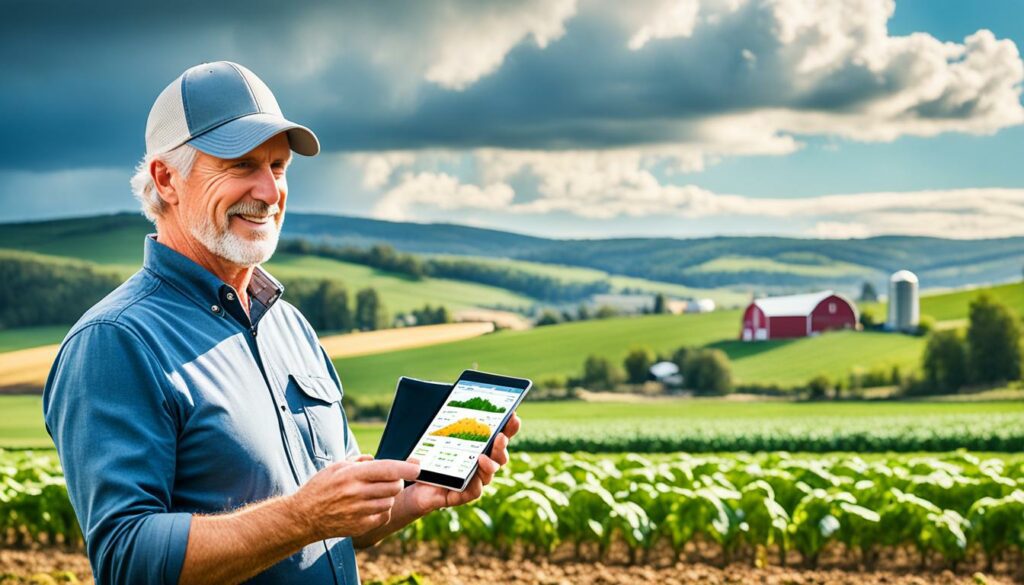
Knowing the local weather is critical for farmers every day. They can decide when to water their crops or add fertiliser. By knowing when it will rain, they can use water better and save resources.
Also, humidity predictions help plan the storage of animal feed. It helps with deciding when to harvest crops too.
Weather apps designed for farmers have changed the game. Apps like NOAA High-Def Radar Pro, Weather Live, and Dark Sky give instant updates. These apps share wind speed data and whether it will rain. This info is essential for quick farm decisions.
Satellite forecasting is very accurate and predicts the weather further ahead. For a more detailed look, some farms use weather stations. These have special sensors for things like soil conditions and UV levels. This makes weather predictions even more precise for that specific area.
Early alerts for bad weather are key for protecting farms from climate change risks. These systems use real-time and predictive data. They help farmers prepare for droughts, floods, and big storms.
Thanks to these tools, farmers can safeguard their crops and animals. They can also plan to use more renewable energy. This prepares their farms to be sustainable for the long haul.
The journey to fight climate change in farming involves many tactics. These include new technologies and methods for sustainable farming. Thanks to teamwork, we’re able to come up with adaptive strategies for a better future. It’s not just about new tech. Strong communities are crucial too. Working together means we can do more to protect our planet.
Studies show farmers don’t meet info providers often. This lack of communication slows down progress. We can change this by using mobiles for better communication. Also, farmers learning from each other can be very helpful. Making ways to work together more easily and looking at the future more can boost how we share information. This would help a lot.
In places like Namibia, climate change is hitting hard. Here, most people depend on farming, making it tough to face losses. Sustainable farming methods can help. By connecting farmers to carbon markets, farming can become both better for the planet and more profitable. This is key to fighting climate issues and staying financially strong.
The Agricultural Climate Markets Collaborative is very important. It sets clear rules for farmers to join eco-friendly programs. It brings together different groups like farmers, companies, and the USDA. Their work makes it easier for farmers to understand their role. It also protects their rights. This initiative should keep going. It helps put farming at the heart of fighting climate change worldwide.
Working together in farming pulls many talents and resources. This helps in creating new ways for sustainable agriculture. It also makes farms more able to handle the ups and downs of climate change.
The world’s weather is getting wilder due to climate change. This means farmers face new challenges like pests and diseases, as well as new weather patterns. They have to smartly change how they farm to tackle these issues.
Different types of crops and animals can help safeguard against failures. Farming in niche areas also helps. Diversification helps farmers deal with changing climates.
New farming tech like precise growing methods and better irrigation are key. These technologies let farmers use resources smarter, helping the environment too.
Not tilling the land too much, varied crops, and keeping soil covered are vital. Using water wisely and recycling it is also very important for the environment.
Teams that share knowledge, from next door or across the world, do better against climate change. They get help from experts and funds, making their farms more adaptable.
These crops can cope with tough weather, saving water and resisting bugs. This means fewer harmful chemicals have to be used on the plants.
Strong, eco-friendly buildings and smart land use are a farm’s shield against harsh weather. They make sure farms can keep going even when the weather is tough.
Knowing the newest and best farming methods helps farmers adapt to our changing climate. It encourages new ideas for facing climate issues head-on.
Government rules can encourage more earth-friendly farming. They also can help when weather disasters strike and back research, making it easier for farmers to adjust.
Some modern farming can harm the earth through heavy water use and greenhouse gases. It’s important to farm in ways that protect our planet for the long term.
Teaming up for the planet between farmers, tech experts, and the government can help a lot. They can cut pollution, boost farm output, and make sure we can all get enough to eat.
By working together on research and making strong local rules, farming can be kinder to our planet. This brings healthy farming practices to life, helping the land and the people living off it.
Knowing what the weather will be helps farmers plan ahead. It stops them from losing crops or animals to bad weather. Accurate forecasts make farmers better prepared for anything.